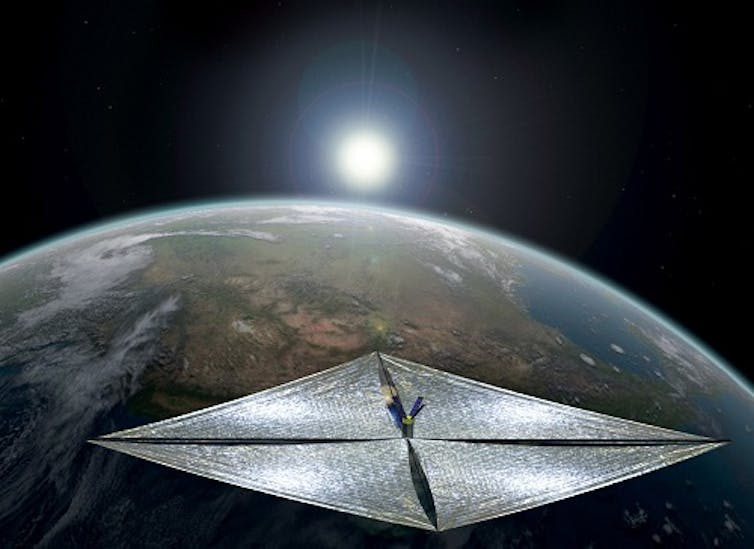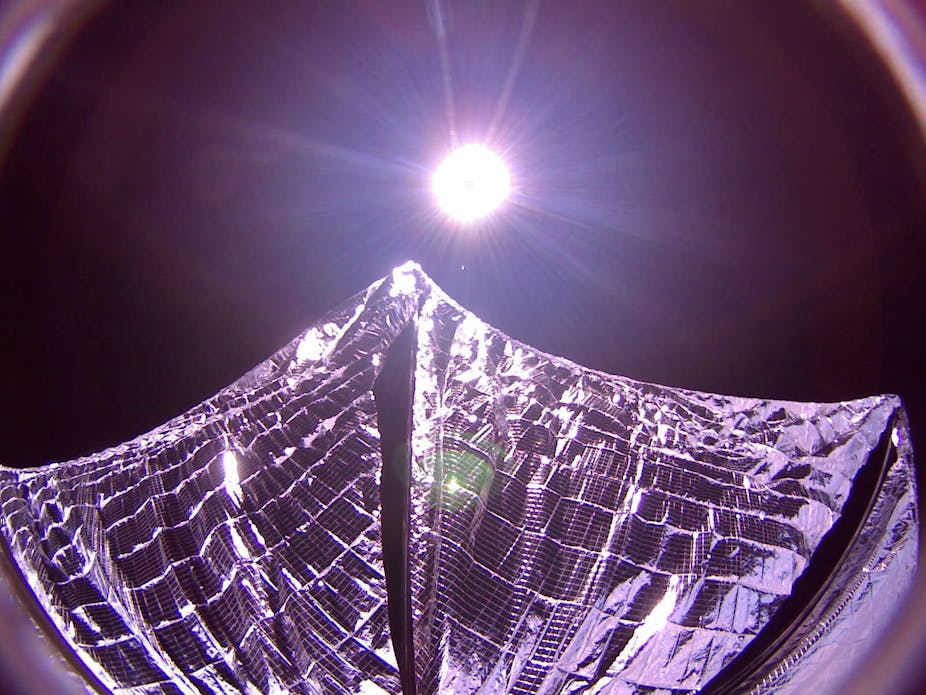A new kind of spacecraft that sails on sunlight has just been successfully deployed above Earth. The LightSail satellite yesterday overcame a series of glitches to unfurl its solar sails, a propulsion system that’s entirely different to traditional rockets, thrusters or even solar panels.
The prototype craft, built by the US Planetary Society and funded by public donations, is testing the sail deployment mechanism. Another mission due to be launched next year will trial the full propulsion system. And it’s not the first spacecraft to fly using solar sailing. That honour went to the Japanese craft Ikaros in 2010. But the growing interest in the technology creates some exciting possibilities for the future of space travel.
Solar sailing is the space equivalent of boat sailing. A boat is pushed along by the air particles that strike its sail when the wind blows. The idea behind solar sailing is the same except, instead of wind, particles of light emitted by the Sun drive the craft forward.
Light is made up of moving particles known as photons that can be reflected by a mirror. When this happens, the mirror experiences a pressure across its surface called solar radiation pressure. This pressure is very small, so you couldn’t feel it just by holding up a normal mirror in sunlight while on Earth. But in the vaccuum of space it’s enough to move a very light mirrored sail.
To understand why solar sailing is important, we need to go back to the emptiness of space. Propulsion is the ability to accelerate a vehicle. Vehicles on Earth accelerate by interacting with something around them. For example, a car accelerates by producing a force on the tarmac.
In space, however, there is no medium to interact with. This is where rocket propulsion comes in. By ejecting propellant in one direction, the rocket is pushed in the opposite direction. This is because of the scientific law (Newton’s Third Law of Motion) that says every time an object exerts a force on another object it experiences an equal and opposite force.
The catch is the propellant on a spacecraft is limited, and once it is all used up, no further no acceleration is possible. Because of this, some distant targets in space are impossible to reach with pure rocketry. Solar sailing, instead, goes elegantly around this this problem by not requiring any propellant mass at all. It is like having a rocket that can thrust for an indefinite amount of time, for free.

The concept of solar sailing is very simple, almost romantic in a sense – and definitely appealing for space exploration. Why then has it not been more widely exploited since its first conception in the 1920s? There are a number of reasons, which are all related to engineering challenges.
The main one is the fact that the solar radiation pressure is very small (hence why you cannot feel any force if you hold a mirror up to the sun). This means solar sails have to be large in order to reflect more light but also lightweight so less force is needed to move them.
And in order to be safely launched, the sail must be folded away and then deployed in weightlessness. The main body of the LightSail craft containing the folded sail is approximately 30cm across at its widest point but the sail deploys with a total area of 32 m2. This deployment mechanism must be very reliable because if it fails, the whole mission is wasted (hence LightSail’s practice launch).
Even with large and lightweight sails, the acceleration can still be small. A solar sail covering two tennis courts would experience a force equivalent to the weight of 1g on Earth. If a spacecraft has a mass of 30 kg, its acceleration will be just 0.0003 m/s2. This sounds extremely small for space standards: even a 1980 Fiat Panda does much better, at about 1 m/s2.
However, a solar sail can orbit the sun over and over, slowly but continuously accelerating (or braking) towards its target. This is why sails are suited for long, interplanetary trips in the solar system. But while the sail can theoretically accelerate forever, practically there are time constraints. Radiation, impacts with micrometeoroids and outgassing (the release of trapped gas from within electronic instruments) can damage the sail material, making it less reflective with time.
The advantage of projects such as LightSail, even though it is a small prototype device, are that they demonstrate the feasibility of the technology and create greater interest and enthusiasm in this mode of flights. LightSail shows that, even a hundred years after being first proposed, solar sailing is still a very popular idea – and scientists (such as ourselves at Space Glasgow) still consider it promising for space exploration.

The hope is that it will attract further substantial investment to the sector in order to develop the technologies required to make solar sailing the main propulsion system of future spacecraft. We are almost there!

